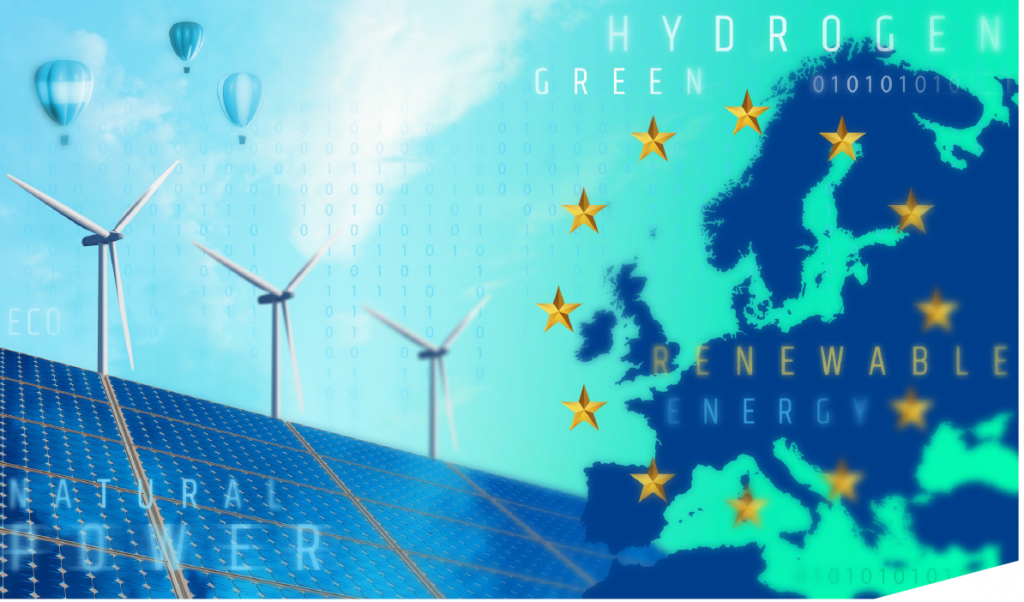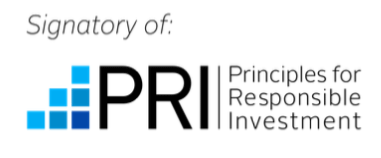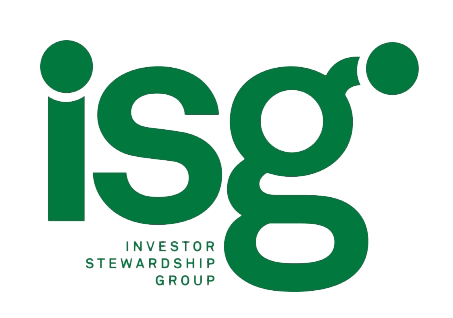Sobre nós
Investimento Responsável
Integral à nossa filosofia de investimento
Há muito que o investimento responsável (IR) é parte integrante do nosso research e das decisões de investimento e, de modo geral, da nossa abordagem de negócio. A lógica do investimento responsável é clara: as empresas com modelos de negócio sustentáveis que olham para o futuro têm mais potencial de criar valor para todos os stakeholders, incluindo os acionistas. Visto que somos signatários fundadores dos Princípios para o Investimento Responsável das Nações Unidas, há mais de uma década que o investimento responsável é um alicerce estabelecido da nossa empresa.
- No centro da nossa abordagem de IR encontra-se uma forte capacidade de research integrada no nosso processo de investimento
- O nosso research é apoiado por classificações próprias de IR que nos permitem avaliar os riscos e oportunidades significativas ESG em mais de 8 mil empresas a nível mundial
- Enquanto gestores ativos, o envolvimento é fundamental e temos um forte historial no que respeita à promoção de mudanças positivas através de gestão e de votação
- Temos uma cultura sólida de colaboração que fundamenta o nosso research e a nossa abordagem ao investimento
- Oferecemos uma gama de estratégias de IR dedicadas, incluindo a nossa franquia inovadora de Obrigações Sociais, para clientes que procuram promover de forma mais ativa os fatores ESG ou alcançar resultados sustentáveis específicos
Na Columbia Threadneedle Investments, esforçamo-nos por ser gestores responsáveis dos ativos dos nossos clientes, afetando o seu capital na nossa estrutura de research sólido e de boa governação. A integração de considerações Ambientais, Sociais e de Governação (ESG) no nosso research proporciona uma imagem mais completa dos riscos e das perspetivas de rendimentos futuros de todas as oportunidades de investimento.
Research
Uma base de research profundo
Acreditamos que o research de investimento responsável corresponde a um research fundamental. Realizamos research original, independente e prospetivo que visa gerar rendimentos consistentes a longo prazo para os nossos clientes.
Os nossos gestores de carteiras tem em consideração as informações complementares dos fatores ESG ao avaliar a sustentabilidade e a criação de valor a longo prazo das empresas incluídas nas carteiras. A integração destes fatores ESG no nosso processo de investimento ajuda os gestores a tomar decisões de investimento que assentam numa base mais ampla.
As nossas classificações próprias de IR refletem a nossa abordagem baseada em dados e provas e proporcionam à nossa equipa de investimento um quadro de investimento responsável sólido para avaliar os riscos e oportunidades significativas ESG em mais de 8 mil empresas a nível mundial. Além de análises próprias, os nossos analistas de IR também realizam research de sustentabilidade independente e temático que providencia informações relativas a investimentos em vários setores – oferecendo uma perspetiva holística das oportunidades de investimento.
Os nossos analistas de IR dedicados fazem parte integrante da nossa equipa de research global e partilham a mesma linha hierárquica. A nossa cultura de research está integrada nas nossas equipas de ações, de rendimento fixo, de imóveis, macro e de ciência de dados que colaboram e partilham informações continuamente por toda a empresa.Esta colaboração resulta em decisões de investimento e atividades de gestão mais informadas e facilita a identificação de oportunidades e riscos significativos que protegem os interesses dos clientes e o capital que nos é confiado.
Análises Próprias
Gestão
As nossas atividades de gestão melhoram a nossa compreensão da nossa exposição a riscos e oportunidades que influenciam a nossa capacidade de criação de valor sustentável a longo prazo para os clientes.
Respeitamos vários códigos de gestão de todo o mundo, incluindo o “Stewardship Code” do Reino Unido, no qual somos um gestor de ativos signatário de “Nível I”, e os Princípios do ISG (Investor Stewardship Group).
Envolvemo-nos com vista a obter informações de research mais aprofundadas, construir relações com empresas e influenciar no sentido da mudança. Acreditamos que o envolvimento melhora o research e o investimento: deteta os pontos de inflexão e as tendências a longo prazo; influencia os padrões de gestão de risco e sustentabilidade ESG das empresas.
Ao tomar decisões relativas ao nosso envolvimento, temos em consideração vários fatores, incluindo:
- a importância de uma questão para a empresa
- o risco para os nossos clientes
- a dimensão da nossa participação
- a nossa oportunidade de colaboração
- e a nossa capacidade de efetuar mudanças

Definimos objetivos claros antes de todas as reuniões de envolvimento, acompanhando-os regularmente. Globalmente, divulgamos por toda a empresa o research e a análise provenientes desta monitorização.
Voto por procuração: fazer ouvir a voz dos nossos clientes
Votamos ativamente nas reuniões da empresa. Consideramos que esta é uma das formas mais eficazes de manifestar a aprovação (ou não) da governação, gestão, conselho de administração e estratégia de uma empresa, bem como um método eficaz para promover mudanças positivas. Votamos pelos nossos clientes em todos os mercados, votamos por todos os nossos fundos e pelos clientes que nos tenham delegado poderes. Votamos tendo em consideração todos os fatores pertinentes a fim de apoiar o melhor resultado económico a longo prazo.
Todos os anos votamos por procuração em cerca de 6.500 assembleias de acionistas em 70 países.
Alterações climáticas
Consideramos o clima no nosso research e na nossa gestão, incluindo envolvimento e votação. Damos prioridade às questões relacionadas com as alterações climáticas relevantes para os nossos investimentos. A título de exemplo, as questões climáticas são financeiramente relevantes para os setores de serviços de utilidade pública, dos combustíveis fósseis e químico, pelo que nestes casos avaliamos as alterações climáticas de forma aprofundada.
Ao examinar alterações climáticas e riscos climáticos significativos, baseamo-nos no enquadramento de relevância desenvolvido pelo Sustainability Accounting Standards Board (SASB – Conselho das Normas de Contabilidade da Sustentabilidade) e nas normas de divulgação consistentes com a Task Force on Climate-related Financial Disclosures (TCFD). Também trabalhamos com o CDP (anteriormente conhecido como Carbon Disclosure Project), um projeto não lucrativo que ajuda as empresas a comunicar o seu impacto ambiental.

Colaborações a nível setorial
Também demonstramos o compromisso que assumimos com o investimento responsável sendo signatários de vários códigos e grupos, incluindo:
- Os Princípios para o Investimento Responsável das Nações Unidas. Fomos um signatário fundador em 2006. Isto significa que há mais de uma década que o investimento responsável é um alicerce estabelecido da empresa.

- Stewardship Code do Reino Unido. Este código, mantido pelo Financial Reporting Council do Reino Unido, estabelece um conjunto de princípios de comum acordo para a gestão por parte dos investidores institucionais das suas participações. Através destes princípios, o Código melhora a qualidade do envolvimento entre os investidores institucionais e as empresas, tornando a governação mais eficaz e eficiente e aumentando os rendimentos ajustados ao risco para os acionistas a longo prazo.
- Investor Stewardship Group. Esta rede norte-americana de investidores e de gestores de ativos promove boas práticas em matéria de gestão e de governo societário.

- UK Women in Finance Charter. Fomos o primeiro gestor de ativos signatário. Os signatários apoiam a participação das mulheres em serviços financeiros. Também estabelecem metas e implementam estratégias adequadas à sua organização e relatam sobre o progresso alcançado face aos objetivos.
Colaboram em várias iniciativas temáticas e de políticas, incluindo:
- A introdução de gilts verdes no Reino Unido. A ideia de uma gilt verde baseia-se na crescente emissão de obrigações soberanas, ambientais e sociais em todo o mundo. Tal constitui um avanço importante no desenvolvimento do mercado global de obrigações verdes, demonstrando a forma como o dinheiro mobilizado pode simultaneamente proporcionar benefícios ambientais, reduzir a desigualdade e ajudar-nos a “reconstruir melhor do que antes”.

Políticas e divulgações
A
Adverse impact
Aggregate sustainability risk exposure
The overall sustainability risk faced by a company or portfolio, taking account of a range of issues such as climate risk and ESG factors.
B
Best-in-class
Best-in-class strategies try to make their portfolios better on ESG issues and/or carbon characteristics by excluding certain investments deemed negative in that respect or including certain investments deemed positive in that respect.
C
Carbon footprint
The carbon emissions and carbon intensity of a portfolio, compared with its investment universe (benchmark). The benchmark might be, for example, companies in the FTSE 100.
Carbon intensity
A company’s carbon emissions, relative to the size of the business. This allows investors to compare the company’s carbon efficiency with its competitors’.
Climate risk
The risk that an investment’s value could be harmed by climate issues such as global warming, energy transition and climate regulation. Investors normally assess climate risk by looking at carbon footprint data, climate adaptation risk, physical risk and stranded assets.
Climate adaptation risk
See Transition Risk.
Controversies
A company’s operational failures or everyday practices that have severe consequences for workers, customers, shareholders, wider society and the environment. Examples are poor employee relations, human rights abuses, failure to follow regulations, and pollution. Controversies help to indicate the quality of a company.
Corporate governance
The way that companies are organised and led. We look at how well companies are sticking to good practices set out in Corporate Governance Codes, which vary from country to country. Corporate governance is also part of the ‘G’ in ESG. In this context Governance may focus on the operational and management practices relating to social and environment aspects of the business.
Corporate Social Responsibility (CSR)
A company’s approach to (and engagement with) its stakeholders and the communities it operates in, reflecting its responsibility towards people and planet.
D
Decarbonisation
The reduction of the carbon emissions associated with a region, country, industry or organisation. It can also refer to the reduction of the carbon emissions associated with a fund’s investments.
Divestment
The opposite of investment. In other words, either reducing or exiting an investment. We divest if we think the potential risks of investing in a company outweigh the potential returns. This may be because we have lost confidence in a company’s leadership, strategy, practices or prospects .
E
Engagement
Talking to members of the board or management of a company – a two-way process that we might initiate, or the company might initiate. We use engagement to understand companies better. We also use it to give feedback, offer advice and seek changes – including change relating to ESG and climate risk. Engagement also means consulting with government and collaborating with other investors to influence policy and shape debate.
Environmental
The “E” in ESG. This covers a focus on significant environmental risks and their management. In a climate change context it is a focus on the risks associated with a business having to adapt to climate change requirements or the physical impacts of climate change. We also look at companies’ environmental opportunities due to changing consumer demands, policy changes, technology and innovation.
ESG
Short for environmental, social and governance. Investors consider companies’ ESG risks and how well they are managed. To do this, we use the Sustainability Accounting Standards Board (SASB) framework. Considering ESG gives us a different perspective on how good an investment might be.
ESG integration
Always taking account of ESG issues when assessing potential investment opportunities and monitoring the investments in a portfolio.
ESG ratings
Many investment managers use external providers, such as MSCI, to rate companies on their ESG practices. Each provider has its own way of doing things, so ESG scores can vary radically from one provider to another. We run our own ESG system to rate companies. This is based on 77 standards, each for a different industry, produced by the Sustainability Accounting Standards Board.
Ethical investing
An ethical approach excludes investments that conflict with the client values and ethics that a fund is seeking to reflect. There are many different activities or issues that people prioritise as ethical. Common examples include tobacco, adult entertainment, controversial weapons, coal or activities that contravene religious social teaching.
Exclusion
Excluding companies from a portfolio. Exclusions can also be used to set minimum standards or characteristics for inclusion of investments in portfolios. Fund managers may exclude entire industries (e.g. tobacco), companies involved in ethically questionable activities (e.g. gambling), companies that fail to meet certain ESG standards, and companies with a bad carbon intensity.
F
Fundamental analysis/research
Using research to work out the true value of an investment, rather than its current price. Many factors contribute to this, including responsible investment factors. Responsible investment helps us understand the quality of a company, its scope to develop and improve (e.g. in response to climate transition) and its prospects (through making money from responding to sustainability issues). Even if a company is good, it is unlikely to offer good investment returns if this is already reflected in the share price.
G
Green bonds
Debt issued by companies or governments, with the money raised earmarked for green initiatives such as building renewable energy facilities.
Greenwashing
Insincere approaches to climate change and other ESG issues by companies, including investment management firms. For example, an investment manager may label a fund as an ESG fund, even if it does not adopt ESG integration in practice.
I
Impact investing
International Labour Organisation (ILO)
A United Nations agency, often abbreviated to “ILO”, that sets international standards for fairness and safety at work. The ILO standards are commonly used by investors to assess how serious a corporate controversy is.
M
Materiality
An ESG issue is “material” if it is likely to have a significant positive or negative effect on a company’s value or performance.
N
Norms-based screening
Screening investments for potential controversies by looking at whether a company follows recognised international standards. We consider standards including the International Labour Organisation standards, the UN Guiding Principles for Business and Human Rights and the UN Global Compact. Specialist RI funds may exclude companies that do not meet these standards.
P
Physical risk
The physical risks of climate change for businesses, such as rising sea levels, water shortages and changing weather patterns.
Portfolio tilts
Investment industry jargon for having more of something in a portfolio than the benchmark, or less of it. In responsible investment it usually means having more companies in a portfolio that have better ESG credentials or are less exposed to climate risk than there is in the benchmark. The tilt is measured as the overall exposure to a specific type of investment in a portfolio compared to that in the benchmark.
Positive inclusion/screening
Seeking companies that have good ESG practices or that help the world economy be more sustainable. Also used as an alternative to “best-in-class“. The opposite of exclusion.
Principles for Responsible Investment
Often shortened to PRI. A voluntary set of six ethical principles that many investment companies have agreed to adopt. Principle 1, for example, is: “We will incorporate ESG issues into investment analysis and decision-making processes.” The PRI was sponsored by the United Nations. Columbia Threadneedle is a founding signatory, and has attained the top A+ headline rating for its overall approach for the sixth year running.
Proxy voting
Voting on behalf of our clients at company general meetings to show support of their practices and approach – or to show our dissent. We put our voting record on our website within seven days of the vote.
R
Responsible Investment (RI)
The umbrella term for our approach towards managing our clients’ money responsibly. This includes the integration of ESG factors, controversies, sustainability opportunities and climate risks into our investment research and engagements with companies, to inform our investment decisions and proxy voting.
Responsible Investment Ratings
Mathematical models created by our responsible investment analysts that provide an evidence-based and forward-looking indication of the quality of a business and its management of risk.
S
Scope 1, 2 and 3 emissions
The building blocks used to measure the carbon emissions and carbon intensity of a company. Under an international framework called the Greenhouse Gas Protocol these are divided into Scope 1, 2 and 3 emissions. Scope 1 emissions are generated directly by the business (e.g. its facilities and vehicles). Scope 2 covers emissions caused by something a company uses (e.g. electricity). Scope 3 is the least reliable because it is the hardest to measure. It covers other indirect emissions generated by the products it produces (e.g. from people driving the cars a company makes).
Screened funds
Funds that use screens to exclude companies that do not meet their ethical criteria, ESG expectations, carbon intensity or controversy standards.
Social
The “S” in ESG. Investors analyse social risks and how these are managed. This includes a company’s treatment of its employees and its human rights record for other people outside the company (e.g. in the supply chain). It also refers to a company’s commercial opportunities in responding to changing consumer demands, policy changes or technology and innovation (e.g housing, education or healthcare).
Social bonds
Bonds issued to raise money for a socially useful purpose, such as education or affordable housing. Social bonds follow the standards set by the International Capital Market Association (ICMA) and appoint independent external reviewers to confirm the money raised will be used appropriately.
Socially Responsible Investing (SRI)
A form of ethical investment that attaches particular importance to avoiding harm to people or the planet, from the investments being made.
Stewardship
A catch-all term to describe the actions taken to look after our clients’ money. It commonly involves both engagement with companies, to develop a proper understanding of business developments, issues and potential concerns; and proxy voting to support or oppose issues at company general meetings.
Stranded assets
A variety of factors can lead to the risk of assets becoming stranded, such as new regulations or taxes (e.g. carbon taxes or changes in emission trading schemes) or changes in demand (e.g. impacts on fossil fuels, resulting from the shift towards renewable energy). Stranded assets risk having their value written down, impacting the value they have in a company’s accounts.
Sub-advisor
When one investment management company hires another investment management company to manage one of their funds, the hired company is the sub-advisor. Sub-advisors are sometimes used in responsible investment if they have specialist knowledge of this field that does not exist in-house.
Sustainability Accounting Standards Board
Often referred to as “SASB”, this is a non-profit organisation that sets standards for the sustainability information companies should communicate to their investors. It has produced 77 sets of industry-specific global standards. SASB looks for sustainability issues that are financially significant to a particular industry.
Sustainability risk
An environmental, social or governance risk that could hit the value of an investment.
Sustainable Development Goals (SDGs)
A set of 17 policy goals set out by the United Nations, which aim for prosperity for all without harming people and the planet. Each goal has a number of targets. For example, Goal 2 is Zero Hunger and Target 2.3 is to double the productivity and incomes of small-scale food producers. Companies can contribute to the SDGs by making products or services that help achieve at least one of the 17 goals.
Sustainable investing
Investing in a way that recognises the need for and supports balanced social, environmental and economic development for the long term.
T
Task Force on Climate-related Financial Disclosures (TCFD)
The Task Force on Climate-Related Financial Disclosures was set up by the World Bank to help companies communicate their climate risks and opportunities and how they manage them. The TFCD sets out a framework for communicating how management considers climate risks, its strategy for responding to climate change, risk management arrangements and the types of risk covered. The TCFD says companies should, for example, explain how their business strategies would cope in different temperature scenarios. From 2022 companies listed on the UK stock market will have to follow the TCFD’s recommendations for disclosing climate risks.
EU SFDR (Sustainable Finance Disclosure Regulation)
This forces funds to communicate how they integrate sustainability risk and consider adverse impacts. For funds promoting environmental or social characteristics or that are targeting sustainability objectives, additional information will need to be communicated.
The EU Taxonomy
Often called the “Green Taxonomy”. This is the EU’s system for deciding whether an investment is sustainable. Investments must contribute to one or more environmental objectives and meet the detailed criteria required for each activity or product that contributes to this. Investments must not do significant harm to any of the objectives. They must also meet minimum standards in business practices, labour standards, human rights, and governance.
Thematic investing
Researching global trends, or “themes”, to identify investments that will either benefit from changing needs or be impacted by them. Common themes are climate change and technological innovation. Often combined with sustainable investing, which looks at these trends but with an additional focus on the environmental or social implications of themes.
Transition risk
The potential risks faced by companies as society transitions towards alignment with the Paris Agreement to limit global warming. This is the risk that a company is so invested in certain incompatible operations and assets that it is uneconomical to transition to align with the Paris Agreement.
U
UN Global Compact (UNGC)
The world’s largest sustainability initiative. The UNGC sets out a framework based on Ten Principles for business strategies, policies and practices, designed to make businesses behave responsibly and with moral integrity. Companies can volunteer to sign the Compact, and can be struck off by the UN for breaking it. The Compact is commonly used by investors to assess how serious controversies are.
UN Guiding Principles for Business and Human Rights
A framework for companies to prevent human rights abuses caused by their activities. Commonly used by investors to assess the severity of companies’ human rights failures.
Também poderá gostar de
Sobre nós
Os nossos fundos
A Columbia Threadneedle Investments tem uma gama abrangente de fundos de investimento que satisfazem uma vasta gama de objetivos.
Responsabilidade social corporativa
Enquanto grupo global de gestão de ativos líder, a Columbia Threadneedle Investments tem como objetivo proporcionar resultados positivos que satisfaçam as necessidades dos nossos stakeholders e comprometemo-nos a agir sempre de forma responsável, transparente e no melhor interesse daqueles que confiam em nós para gerir os seus investimentos.
